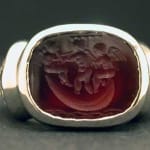Roman Carnelian Intaglio Depicting Three Cupids, 100 CE - 300 CE
Carnelian-Gold
FJ.6819
This Genuine Ancient Seal Has Been Set in a Modern 18 Karat White Gold Rin The art of glyptics, or carving images on colored precious stones, is probably one of...
This Genuine Ancient Seal Has Been Set in a Modern 18 Karat White Gold Rin
The art of glyptics, or carving images on colored precious stones, is probably one of the oldest known to humanity. Intaglios, gems with an incised design, were made as early as the fourth and third millennia B.C. in Mesopotamia and the Aegean Islands. They exhibit a virtuosity of execution that suggests an old and stable tradition rooted in the earliest centuries. The tools required for carving gems were simple: a wheel with a belt-drive and a set of drills. Abrasives were necessary since the minerals used were too hard for a metal edge. A special difficulty of engraving intaglios, aside from their miniature size, was that the master had to work with a mirror-image in mind.
A most unusual scene has been engraved onto the polished surface of this precious gemstone: three Cupids ride together in a crescent-shaped boat. The two putti on the left appear to be playing flutes to pass the time as the third sits on the prow and maintains the sail. While this scene might have a literary basis in ancient mythology or proverbs, it has been lost to us today. Yet we can revel in the mystery and invent our own legends to describe this scene. What events might lead three Gods of Love to embark upon the open sea together? Perhaps this intaglio represents an allegory of love. For in order to find true love, we must be willing to leave the comfort of land and set course upon the rough waves and blustery storms of unknown waters. Here, three Cupids lead the way, navigating the way to the island paradise of love.
The art of glyptics, or carving images on colored precious stones, is probably one of the oldest known to humanity. Intaglios, gems with an incised design, were made as early as the fourth and third millennia B.C. in Mesopotamia and the Aegean Islands. They exhibit a virtuosity of execution that suggests an old and stable tradition rooted in the earliest centuries. The tools required for carving gems were simple: a wheel with a belt-drive and a set of drills. Abrasives were necessary since the minerals used were too hard for a metal edge. A special difficulty of engraving intaglios, aside from their miniature size, was that the master had to work with a mirror-image in mind.
A most unusual scene has been engraved onto the polished surface of this precious gemstone: three Cupids ride together in a crescent-shaped boat. The two putti on the left appear to be playing flutes to pass the time as the third sits on the prow and maintains the sail. While this scene might have a literary basis in ancient mythology or proverbs, it has been lost to us today. Yet we can revel in the mystery and invent our own legends to describe this scene. What events might lead three Gods of Love to embark upon the open sea together? Perhaps this intaglio represents an allegory of love. For in order to find true love, we must be willing to leave the comfort of land and set course upon the rough waves and blustery storms of unknown waters. Here, three Cupids lead the way, navigating the way to the island paradise of love.



